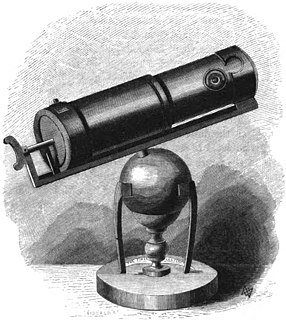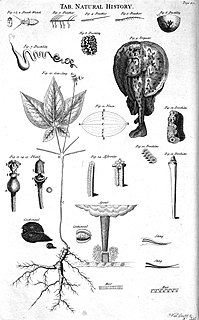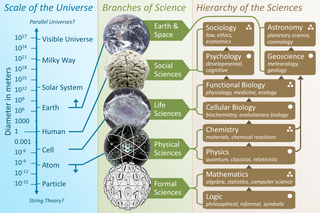
The history of science is the study of the development of science, including both the natural and social sciences. Science is a body of empirical, theoretical, and practical knowledge about the natural world, produced by scientists who emphasize the observation, explanation, and prediction of real-world phenomena. Historiography of science, in contrast, studies the methods employed by historians of science.

A manuscript was, traditionally, any document that is written by hand — or, once practical typewriters became available, typewritten — as opposed to being mechanically printed or reproduced in some indirect or automated way. More recently, the term has come to be understood to further include any written, typed, or word-processed copy of an author's work, as distinguished from its rendition as a printed version of the same. Before the arrival of printing, all documents and books were manuscripts. Manuscripts are not defined by their contents, which may combine writing with mathematical calculations, maps, music notation, explanatory figures or illustrations.

Science is a systematic enterprise that builds and organizes knowledge in the form of testable explanations and predictions about the universe.

Social science is the branch of science devoted to the study of human societies and the relationships among individuals within those societies. The term was formerly used to refer to the field of sociology, the original "science of society", established in the 19th century. In addition to sociology, it now encompasses a wide array of academic disciplines, including anthropology, archaeology, economics, human geography, linguistics, management science, media studies, musicology, political science, psychology, welfare and nursing studies and social history.

A scientist is someone who conducts scientific research to advance knowledge in an area of interest.
Historians of science and of religion, philosophers, theologians, scientists, and others from various geographical regions and cultures have addressed numerous aspects of the relationship between religion and science. Critical questions in this debate include whether religion and science compatible, whether religious beliefs can be conducive to science, and what is the nature of religious beliefs.

Natural science is a branch of science concerned with the description, prediction, and understanding of natural phenomena, based on empirical evidence from observation and experimentation. Mechanisms such as peer review and repeatability of findings are used to try to ensure the validity of scientific advances.

Natural history is a domain of inquiry involving organisms, including animals, fungi and plants, in their natural environment, leaning more towards observational than experimental methods of study. A person who studies natural history is called a naturalist or natural historian.

Natural philosophy or philosophy of nature was the philosophical study of nature and the physical universe that was dominant before the development of modern science. It is considered to be the precursor of natural science.

The word miniature, derived from the Latin verb miniare indicates a small illustration used to decorate an ancient or medieval illuminated manuscript; the simple illustrations of the early codices having been miniated or delineated with that pigment. The generally small scale of such medieval pictures has led to etymological confusion with minuteness and to its application to small paintings, especially portrait miniatures, which did however grow from the same tradition and at least initially used similar techniques.

Picatrix is the name used today, for a 400-page book of magic and astrology originally written in Arabic under the title غاية الحكيمGhāyat al-Ḥakīm, which most scholars assume was originally written in the middle of the 11th century, though an argument for composition in the first half of the 10th century has been made. The Arabic title translates as The Aim of the Sage or The Goal of The Wise. The Arabic work was translated into Spanish and then into Latin during the 13th century, at which time it got the Latin title Picatrix. The book's title Picatrix is also sometimes used to refer to the book's author.

The History of Science Museum in Broad Street, Oxford, England, holds a leading collection of scientific instruments from Middle Ages to the 19th century. The museum building is also known as the Old Ashmolean Building to distinguish it from the newer Ashmolean Museum building completed in 1894. The museum was built in 1683, and it is the world's oldest surviving purpose-built museum.
The nature study movement was a popular education movement that originated in the United States and spread throughout the English-speaking world in the late 19th and early 20th centuries. Nature study attempted to reconcile scientific investigation with spiritual, personal experiences gained from interaction with the natural world. Led by progressive educators and naturalists such as Anna Botsford Comstock, Liberty Hyde Bailey, Louis Agassiz, William Gould Vinal, and Wilbur S. Jackman, nature study changed the way science was taught in schools by emphasizing learning from tangible objects, something that was embodied by the movement's mantra: "study nature, not books". The movement popularized scientific study outside of the classroom as well, and has proven highly influential for figures involved in the modern environmental movement, such as Aldo Leopold and Rachel Carson.
Formal science is a branch of science studying formal language disciplines concerned with formal systems, such as logic, mathematics, statistics, theoretical computer science, artificial intelligence, information theory, game theory, systems theory, decision theory, and theoretical linguistics. Whereas the natural sciences and social sciences seek to characterize physical systems and social systems, respectively, using empirical methods, the formal sciences are language tools concerned with characterizing abstract structures described by symbolic systems. The formal sciences aid the natural and social sciences by providing information about the structures the latter use to describe the world, and what inferences may be made about them.

During the Renaissance, great advances occurred in geography, astronomy, chemistry, physics, mathematics, manufacturing, anatomy and engineering. The rediscovery of ancient scientific texts was accelerated after the Fall of Constantinople in 1453, and the invention of printing democratized learning and allowed a faster propagation of new ideas. But, at least in its initial period, some see the Renaissance as one of scientific backwardness. Historians like George Sarton and Lynn Thorndike have criticized how the Renaissance affected science, arguing that progress was slowed for some amount of time. Humanists favoured human-centered subjects like politics and history over study of natural philosophy or applied mathematics. Others have focused on the positive influence of the Renaissance, pointing to factors like the rediscovery of lost or obscure texts and the increased emphasis on the study of language and the correct reading of texts.

Humboldtian science refers to a movement in science in the 19th century closely connected to the work and writings of German scientist, naturalist and explorer Alexander von Humboldt. It maintained a certain ethics of precision and observation, which combined scientific field work with the sensitivity and aesthetic ideals of the age of Romanticism. Like Romanticism in science, it was rather popular in the 19th century. The term was coined by Susan Faye Cannon in 1978. The example of Humboldt's life and his writings allowed him to reach out beyond the academic community with his natural history and address a wider audience with popular science aspects. It has supplanted the older Baconian method, related as well to a single person, Francis Bacon.
19th-century science was greatly influenced by Romanticism, an intellectual movement that originated in Western Europe as a counter-movement to the late-18th-century Enlightenment. Romanticism incorporated many fields of study, including politics, the arts, and the humanities.

The branches of science, also referred to as sciences, "scientific fields", or "scientific disciplines," are commonly divided into three major groups:

European science in the Middle Ages comprised the study of nature, mathematics and natural philosophy in medieval Europe. Following the fall of the Western Roman Empire and the decline in knowledge of Greek, Christian Western Europe was cut off from an important source of ancient learning. Although a range of Christian clerics and scholars from Isidore and Bede to Jean Buridan and Nicole Oresme maintained the spirit of rational inquiry, Western Europe would see a period of scientific decline during the Early Middle Ages. However, by the time of the High Middle Ages, the region had rallied and was on its way to once more taking the lead in scientific discovery. Scholarship and scientific discoveries of the Late Middle Ages laid the groundwork for the Scientific Revolution of the Early Modern Period.

De materia medica is a pharmacopoeia of medicinal plants and the medicines that can be obtained from them. The five-volume work was written between 50 and 70 CE by Pedanius Dioscorides, a Greek physician in the Roman army. It was widely read for more than 1,500 years until supplanted by revised herbals in the Renaissance, making it one of the longest-lasting of all natural history books.















